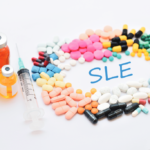A phase 3 clinical trial in which researchers treated lupus patients with blisibimod, a biologic treatment that inhibits B cell activating factor (BAFF), did not meet its primary endpoint, but did demonstrate evidence of possible efficacy.
Researcher Joan T. Merrill, MD, a member of the Oklahoma Medical Research Foundation (OMRF) and OMRF professor of medicine at the University of Oklahoma, says that in a previous phase 2 clinical trial of this treatment, it appeared the sickest subset of patients benefited from treatment. The phase 3 trial, therefore, was enriched for patients with more disease activity, she says. The study’s objective was to evaluate the safety and efficacy of blisibimod in this more acutely ill population, including some patients with stable nephritis.
Phase 3 trials of more than 4,000 systemic lupus erythematosus (SLE) patients have evaluated targeted BAFF inhibitors in past years. “BAFF, also known as BLyS, is key in activating and prolonging survival and differentiation of B cells,” Dr. Merrill says. Analyses of these past studies tended to identify greater treatment effects in patients entering with higher disease activity, greater corticosteroid doses, anti-double-stranded DNA (anti-dsDNA) antibodies and low complement C3 or C4.

Dr. Merrill
This randomized, double-blind, placebo-controlled trial of blisibimod evaluated 442 patients with SLE. The patients received weekly subcutaneous blisibimod (200 mg) or placebo and were encouraged to taper their corticosteroids from Week 8. Those given blisibimod generally tolerated it well. The most common adverse events were typical for lupus trials, including upper respiratory and urinary tract infections, injection-site reactions and gastrointestinal disorders. The trial did not meet its primary endpoint of SRI-6, which requires a six-point reduction on the SLED Disease Activity Index (SLEDAI) without meaningful increases in two other measures. Nevertheless, the study revealed some indications of possible treatment efficacy. More blisibimod-treated subjects were able to taper their corticosteroids to </= 7.5 mg/day prednisone or equivalent, which was statistically significant at all timepoints after Week 24. There was also an increase in the SRI-6 treatment difference when only those who had achieved the steroid taper milestone were considered (P=0.056).
In those who entered the study with a urinary protein:creatinine ratio (UpCr) of ≥56.5 mg/mmol (500 mg/gm), a significantly higher proportion of blisibimod-treated subjects achieved >50% reduction, which was statistically significant at multiple timepoints. Reductions in SLE autoantibodies and increases in complement C3 and C4 were also observed with blisibimod.
Blisibimod is a peptibody (constructed to contain elements of a peptide and an antibody) that targets both membrane-bound and circulating BAFF. Belimumab (Benlysta), which also targets BLyS, binds only its circulating form. In lupus, inflammation is like a vicious circle, Dr. Merrill says. “Something triggers type I interferons to be made, and these, along with other triggers, induce the production of BAFF, which is appreciated to be a central player in the classic B cell pathology in lupus,” she says. “Then the inflammation that results from BAFF activity goes around to promote more type I interferons to be made.” BAFF (BLyS) inhibitors attempt to interrupt this flow.
Approved in 2011, belimumab is the only new FDA-approved drug for lupus in more than 60 years. Prior to that, the only approved drugs for lupus were steroids, antimalarials and aspirin.
“If you tried to take care of lupus patients with just steroids, antimalarials and aspirin,” says Dr. Merrill, “you’d be committing malpractice. So we end up borrowing drugs from other diseases that haven’t been studied all that well for lupus, and, aside from belimumab, that’s our standard of care.”
Personalized Medicine
Lupus, a heterogeneous disease that presents clinically with a large variety of symptoms and comorbidities from patient to patient, can be enormously complicated to treat. “When you try to [use] biomarkers or blood tests to figure out the difference between these patients, what you find is that they usually have overlapping features and they often have unique features,” Dr. Merrill says.
One of the ways researchers are beginning to approach this problem is to study the activation of immunologic pathways in large populations of lupus patients. “Heat maps showing the expression of large arrays of genes give us complex geographic maps as the body begins to respond to different immunologic triggers,” Dr. Merrill says. “We are getting better at sorting this into interpretable patterns and, thus, clustering our patients into meaningful subsets.” Eventually these patterns may become helpful in deciding which drugs to try first for which patients.
“A lot of people feel like this is not worth doing, because you’re never going to get it perfect, and I won’t be able to tell my patient who walks into my office, ‘I’m putting you on this drug and it’s definitely going to work for you,’” Dr. Merrill says. “But if I walked into a doctor’s office and I was told, ‘I’m not going to bother. I’m just going to give you any old drug because we can’t figure it out,’ I would say, ‘Well, can you guess better?’”
Dr. Merrill suggests that if rheumatologists could tell patients they have a 70% chance of responding to a particular drug rather than a 40% chance, this would improve medical care in a profound manner. “So that’s where we are. We’re trying to get to 70%,” she says. “We’re probably not going to get to 100% in the near future, but we’re trying to get to 70%.”
In fact, decreasing the uncertainty of treatment selection may enable physicians to better defend the decision to try an expensive new treatment with a particular patient as it comes on the market. “I think maybe we can have a conversation with both the FDA and the insurance companies if we could provide evidence for something like, “This group of patients has a 70% chance to respond and this group of patients has a 30% chance to respond. We don’t want to make a treatment forever unavailable to the 30% group, but we might be able to agree that they should try something else first and leave the less likely treatment as a later resort.”
Although blisibimod won’t be on the market in the near future because it did not meet its primary endpoint, Dr. Merrill believes it should be studied further. “One thing we understand about our field now is that it’s going to be complicated,” she says. “We need to put some time and energy into figuring out not just whether a drug works, but how it should be used, or where it fits in with what patients, and when and what medications it could or should be combined with.”
A better understanding of patient subsets and how background treatments affect these subsets would change everything for lupus treatment development, says Dr. Merrill. Specifically, she’s referring to identifying the patients most likely to benefit from any given treatment mechanism and eliminating patients who have no chance of responding, improving the interpretation of trials and providing a major advance in clinical care.
“You can’t overestimate the importance of our community of treatment developers, basic scientists and clinical rheumatologists working together to find a more sophisticated approach to studying drugs and applying them in practice. It illustrates some of the problems we need to solve in our field,” Dr. Merrill says, “problems that extend beyond lupus to all of our complex rheumatologic diseases.”
Renée Bacher is a frequent contributor to ENT Today and the AARP Bulletin. Her article about heart disease in women, “This Story Could Save Your Life,” won a recent National Health Information Award for Family Circle magazine.
Reference
- Merrill JT, Shanahan WR, Scheinberg M, et al. Phase III trial results with blisibimod, a selective inhibitor of B-cell activating factor, in subjects with systemic lupus erythematosus (SLE): Results from a randomised, double-blind, placebo-controlled trial. Ann Rheum Dis. 2018 Jun;77(6):883–889.


